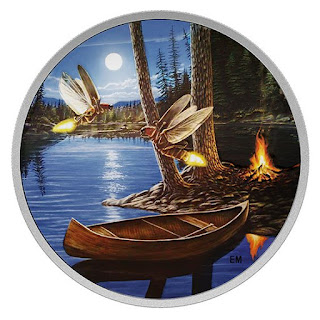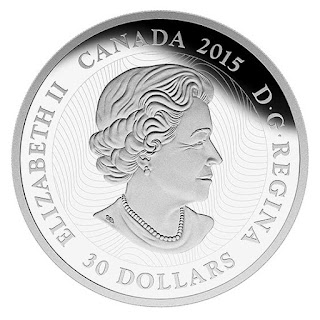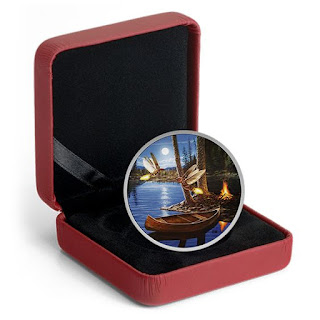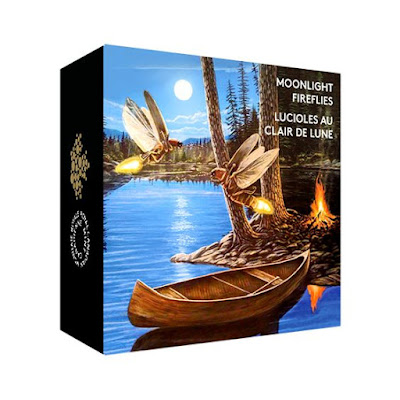Canada 30 Dollars Silver Glow-in-the-Dark Coin 2015 Moonlight Fireflies
The obverse features the effigy of Her Majesty Queen Elizabeth II by Susanna Blunt.
The entire reverse image by Canadian artist Ervin Molnar combines rich colours and detailed engraving to recreate the beauty of a moonlit night in the Canadian wilderness. Twilight brings tranquility to the forest, where a canoe has brought campers to rest along the shore for the night. There is an added element of magic in the warm night air as fireflies take flight and intermittently light up the darkness. In the foreground, two fireflies can be viewed up close and in great detail, with colour recreating their delicate wings and markings along their abdomens. But the full effect of the coin is best viewed in the dark after placing it in a light source for 30 to 60 seconds; photo-luminescent technology transports the viewer into the coin’s campsite by recreating the only sources of light: the enchanting spark of light emitted by the fireflies, along with the campfire’s amber flames and the bright full moon that are reflected on the still surface of the water.
Mintage: 4000.
Composition: 99.9% pure silver.
Finish: proof.
Weight: 62.7 g.
Diameter: 54 mm.
Edge: serrated.
Face value: 30 Canadian Dollars.
Artist: Ervin Molnar (reverse), Susanna Blunt (obverse).
Manufacturer: Royal Canadian Mint.
• A FIRST: Glow-in-the-dark technology on a 2 oz. silver coin!
• Photo-luminescent (glow-in-the-dark) elements recreate the magic of seeing a firefly on a moonlit night in the Canadian wilderness.
• Detailed engraving and the use of colour on the entire reverse create a dazzling image, while Royal Canadian Mint-first, multi-coloured, glow-in-the-dark technology with variable intensity adds a beautiful glow to the moon, the fire, and the fireflies.
• The effect occurs after placing the coin in a light source for 30 to 60 seconds, then bringing it into the dark to experience the sight of fireflies at a campsite — even visible through the capsule!
• Crafted from 99.99% pure silver with a limited mintage of 4,000 worldwide.
They are mysterious, elusive, almost magical; when twilight descends, these little creatures suddenly make their presence known as they fly lazily in the hot summer air, flickering and twinkling like miniature shooting stars that seem to be within reach. Fireflies (Lampyridae) prefer to live in moist environments, which is why many cherish childhood memories of trying to catch them while camping in forested areas or spending time near Canada’s many lakes and rivers. Their luminescence is an object of fascination—an effect that has been recreated on this beautifully coloured coin using glow-in-the-dark technology!
While not every firefly flashes, they are the only insects that are capable of flashing distinct patterns as a method of communication to attract a mate, or as a warning to predators. Fireflies are also bioluminescent as larvae, although they are rarely seen at any other time than in their adult stage; it is then that their appearance on a summer night adds a spellbinding quality to the beauty of Canada’s great outdoors.
In the natural world, the firefly’s bioluminescence is generated by dedicated light organs that are located under their abdomens; there, two chemicals called luciferin and luciferase mix with oxygen, magnesium and adenosine triphosphate (ATP) to emit the glow that gave the insect its name.
On your coin’s reverse, however, the firefly’s glow is recreated using photo-luminescent—or glow-in-the-dark— technology that is activated by placing the coin in a light source for 30 to 60 seconds; moving into darkness, you will view the elements as though you were approaching the lakeside campsite in the image, where the only sources of light are the full moon and the campfire that reflect on the water’s surface. It’s the perfect opportunity to experience the enchantment of seeing the fireflies’ spark light up the darkness time and time again, at any time of the year, with this incredible addition to your coin collection.
• Also known as “lightning bugs,” fireflies aren’t actually flies or bugs—they’re beetles.
• Fireflies are found on nearly every continent, with roughly 2,000 different firefly species in the world; in Canada, the most common species is Photinus pyralis, which is a dark brown colour with orange and yellow markings.
• An adult firefly only lives long enough to mate and reproduce, so it is thought that they do not need to eat during this stage of their life cycle.
• Fireflies are the most efficient producers of light in the world: while an incandescent bulb emits 90% of its energy as heat and only 10% as light, fireflies glow without producing any heat energy.
• Each species emits a different pattern of signals: a male Photinus pyralis will emit a short flash as it rises to create a J shape, while a male Photinus consimilis uses a flurry of flashes to attract a mate’s attention.




